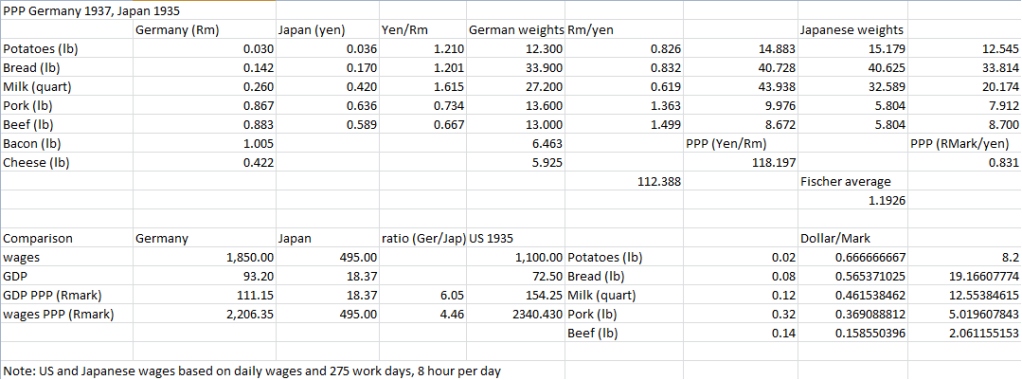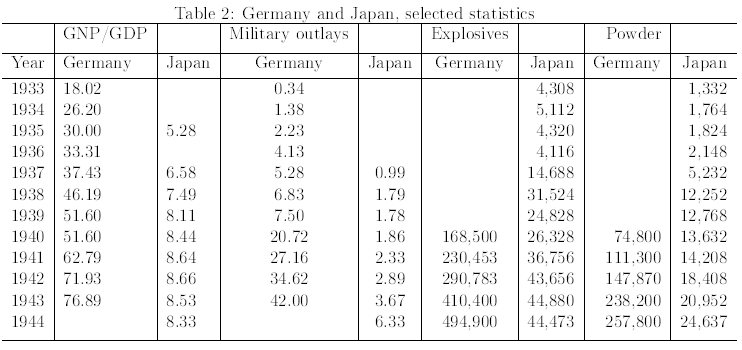GNP/GDP MER billions of current dollars:
-------- Germany ---------- Japan ------- ratio
1935 --- 30.00 ------------- 5.278 ------- 5.684
1936 --- 33.30 ------------- NA ---------- NA
1937 --- 37.43 ------------- 6.583 ------ 5.686
1938 --- 46.18 ------------- 7.498 ------ 6.159
1939 --- 51.60 ------------- 8.112 ------ 6.361
Size of the labor force in 1939, thousands and nominal productivity:
Germany --- 40,630 --------- 1,269.90
Japan ------ 32,759 --------- 247,60
In 1939, the average price of a machine tool sold in Japan was 4,108 yen. Japan’s GDP was 31.23 billion yen. Which means it was equivalent to 7.6 million machine tools. While the average price of a machine tool sold in Germany was 3,485 Rm and Germany’s GNP was 129 billion Rm, which means it was equivalent to 37.02 million machine tools, a ratio of 4.87.
In terms of market exchange rates, in 1939 Japan’s GDP was 8.1 billion dollars, while Germany’s GNP was 51.6 billion dollars, a ratio of 6.37. But note that Germany’s machine tools were generally of superior quality, as Germany was the world’s leading exporter/producer of machine tools in the 1930’s. So the machine tool GDP underestimates Germany in relation to Japan.
Using other products, in terms of food, in 1935 a pound of bread sold in Japan for 0.17 yen (11), while GDP was 18.37 billion yen. So GDP was equivalent to 108 billion pounds of bread. In Germany 1937, a pound of bread sold for 0.1415 Rm (10), while GNP was 93.2 billion Rm, equivalent to 659 billion pounds of bread. That’s 6.1 times larger than Japan’s GDP 2 years earlier and fits closely the MER ratio. If we use meat prices, a pound of pork sold for 0.867 Rm (10) in Germany, 1937, while it sold for 0.7 yen (11) in Japan 1935. Producing a closer GDP ratio of 4.1. While a quart of milk sold for 0.26 Rm (10) in Germany and 0.42 yen (11) in Japan, producing a GDP ratio of 8.2. The average of the three ratios is 6.13, fitting closely the 6.37 ratio obtained from exchange rates in 1939.
I have made a more detailed set of calculations here:

Germany’s economy was much larger and more powerful than Japan’s, also was more technologically advanced and so could produce more munitions in proportion to it’s GDP. In 1943, for instance, Germany produced 410,400 tons of explosives and 238,200 tons of powder, while Japan produced 44,880 tons of explosives and 20,952 tons of powder. (12) This huge discrepancy helps to explain the huge discrepancy in Allied casualties in fighting Germany and Japan as explosives and powder determine the total amount of energy released by the weapons systems of both countries and thus are indicators of available firepower to the armed forces.
